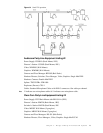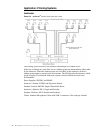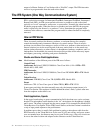
Chapter 3 - Design of Party-Line Intercom Systems 33
In some more extreme cases, only a single pair of wires may be available. In this case, plug
the talent’s stereo headset into the stereo connection on the talent receiver, then connect
the high side of the pair to pins 2 and 3 of the XLR3 connector and the low side to pin 1
(pseudo-stereo mode). This will give a mono feed with each ear individually adjustable
and both ears interrupted.
For runs of two miles of number 22 gage twisted pair, at least one talent receiver station
should be operable. For a run of one mile, two talent stations should be operable.
Some users have increased the number of talent stations by using higher impedance (300
ohms) headsets. In the case of auto racing and similar loud environment situations, low
impedance noise isolating headsets will be necessary to overcome the volume and amount
of sound. It may be necessary to use a four wire circuit to connect up each talent station,
paralleling the pairs, and running the talent receiver in pseudo-stereo mode, using only the
interrupt (“wet”) output of the IFB electronics.
Field Application, ENG (Electronic News Gathering)
In this case, the earphone is again hidden as in the studio case above. If the talent has to
carry on a conversation with other talent at the studio and other venues, the program feed
should be a mix minus feed. The mix minus feed will allow the talent to hear the other
talents loud enough without hearing their own self too loud.
Connecting (Interfacing) to Other Communications Systems
What is interfacing? Interfacing is either:
1 The interconnection of two normally separate communications systems into one
system.
-OR-
2 The connection of a communications station or device that is not directly compatible
within a system.
To accomplish this, voice and data information is adjusted and then transmitted to the
other system. The adjustments include level translation, impedance compensation, mode
translation, and compensation for parameters of each system.
Some examples are:
1 System to system: connection of a four-wire matrix system installed on a large mobile
unit to two-wire belt packs outside of the mobile unit.
2 System to terminal: connection of a camera with a built-in intercom to an intercom
system, or connection of a radio transceiver into an intercom system.
Why is there interfacing, operationally? From an operations point of view:
1 An operation requires a larger collection of personnel and equipment than normal.
2 A mobile unit is used with a permanent installation to conduct an operation.
3 Coordination between personnel / equipment is required at a remote location.
4 A special part of the operation requires communication with an odd system or terminal.
5 A redundant “backup” path is required.
Why is there interfacing, technically? There are system to system, system to terminal or,
system to device differences.


















